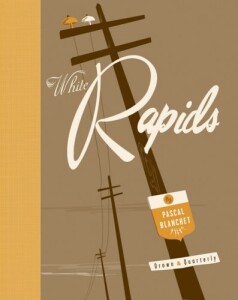 The history of Canada has not been used for too many movies. We’re a peaceful people, and we seek to live with each other, with as little conflict as possible. No civil wars, no struggle between cowboys and Indians (well — not too much). Our conflicts are political. And they’re settled politically. We have a rebellion … we just take the leaders to trial, and hang ’em! No problem. This newly translated from the French graphic novel tells the story of one of these political events that shaped the story of Quebec, and reflects the way things tend to happen in the Great White North.
The history of Canada has not been used for too many movies. We’re a peaceful people, and we seek to live with each other, with as little conflict as possible. No civil wars, no struggle between cowboys and Indians (well — not too much). Our conflicts are political. And they’re settled politically. We have a rebellion … we just take the leaders to trial, and hang ’em! No problem. This newly translated from the French graphic novel tells the story of one of these political events that shaped the story of Quebec, and reflects the way things tend to happen in the Great White North.
White Rapids is the story of a town called Rapides Blanc located along the Maurice River. Before the mid-’30s that town didn’t exist. It was where the rapids were. No roads. The train didn’t stop there. Then the Shawinigan Water & Power Company decided to expand and construct a hydro plant at the rapids. When asked where the workers would live, management said, “In the town we’ll build.” Then they did it, built a town, equal to the latest suburbs in Montreal, to attract workers. It was beautiful. And the plan worked. The plant was built, the houses constructed, schools, churches . . . eventually roads, and a train station. Civilization arrived. And everyone was happy. Well, half were happy, les autres … heureux!
The town grew, people thrived. Sure it was cold, very cold in the winter, so they developed a fine curling rink. The sense of community was remarkable. Fishing became the activity of choice the rest of the year. A giant pike they called the General was each angler’s nemesis.The years passed. The town progressed.
But with progress comes change. Hydro-electric power was taken from the private sector into the public sector. The province bought up the Shawinigan Water & Power Company. They closed the plant. The town died.
Blanchet’s elegant little book tells this story. In pictures with few words. Just enough words to fill you in on the details. And just enough pictures to make you appreciate what a fine artist and storyteller Blanchet is. His style is sleek, stylized, a blend of Art Deco and mid-’50s graphic design. Think of movie posters, or paperback art: cartoony and solid, yet vibrant and alive. All done in orangy monochrome, it’s the kind of design that D+Q artists do best.
Planchet mixes the tragedy of the political reality, with some well imagined fictions describing the lives lived in Rapides Blanc, and this makes White Rapids a stunning, moving little book.
(Drawn + Quarterly, 2007)
